


The following are conversions from long time visitor from England, Dave Keen, who is apparently a professional figure converter and painter. Mr. Keen's own comments are in quotes:
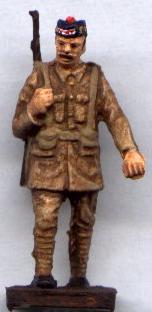 "First up, we have a private of the Royal Scots Fusiliers, 1914. This is an Airfix British Infantryman with the head of the Esci Zulu Wars British soldier wearing his glengarry. Looking rather nonchalant, he is perhaps still expecting to be in Berlin by Christmas."
"First up, we have a private of the Royal Scots Fusiliers, 1914. This is an Airfix British Infantryman with the head of the Esci Zulu Wars British soldier wearing his glengarry. Looking rather nonchalant, he is perhaps still expecting to be in Berlin by Christmas."
Very interesting figure and period. There is a dearth of WWI figures in the market despite the fact that this was only one of two conflicts big enough to be named a "world" war. In fact it was called the Great War before the second one came along. Note the drybrushing techinique that brings out the griminess of one who's just been in the trenches. The face is so well painted that it looks more like it is from a 54mm figure than a 1/72 scale figure.
"Next, we have French Infantry from the Franco-Prussian War. In fact, the appearance of the French Infantry changed little between the Crimean War and the start of WW1, so these figures could fit into a variety of conflicts over half a century. These figures are Airfix French Foreign Legion from the neck down, and Italeri American Civil War infantry from the neck up (the reason they are Iterali is because only they gave their ACW figures standing collars)."
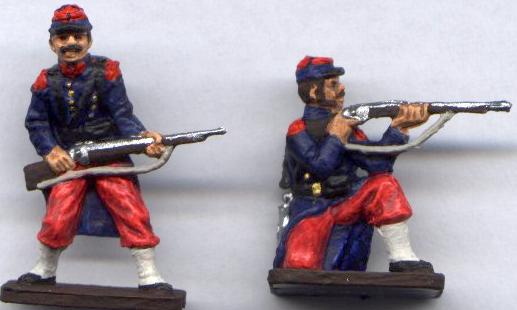
Yup, why change a good thing? The French uniform looked smart and had elan. The French were undergoing a renaissance of arms under the second Napoleon (named the III, did they skip one?), and French feat of arms was unchallenged against the Russians and a host of colonials until the F-P War. Speaking of which, the F-P War is non represented in the plastics world. These are two very good conversions. The painted on epaulettes look good. A lot of character has been painted on the face, these look like Frenchmen.
"On to the catwalk now are British Heavy Dragoons from the Crimean War. These are of course Scots Greys as they appeared during the second most famous cavalry action of the war, the charge of the Heavy Brigade. During much of the nineteenth century the British were obliging enough to make only very minor changes to the dress of their cavalry, mostly confining themselves to variations in colour and headress. I was therefore able to utilise a Revell Napoleonic Lifeguard and an Italeri Napoleonic Scots Grey for their bodies. The heads previously belonged to some Airfix Bandsmen."
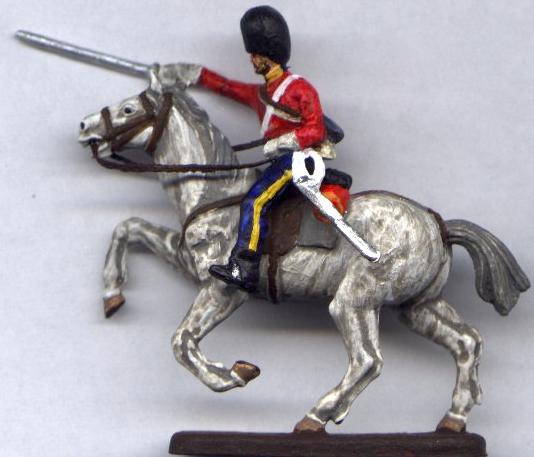
The most famous cavalry action was of course the charge of the Light Brigade which all British boys learned about by the time they were 10. I've often wondered how General Scarlett felt, all the fame, Tennyson and all, going to the Light Brigade, I bet that made him want to charge a Russian cannon or two. Despite the difference of 100 years that bearskin from the Guards Band looks perfect, facial hair only enhances the verisimilitude. Now all we need are the Russians.
"Coming next is a British Heavy Dragoon, 1815. This chap represents the 6th Inniskilling Dragoons, who played a large part in the charge of the Union Brigade at Waterloo, but have so far avoided being immortalised in plastic by any manufacturer. Here again a British Napoleonic cavalryman's body has been used, topped by an Esci French Cuirassier head."
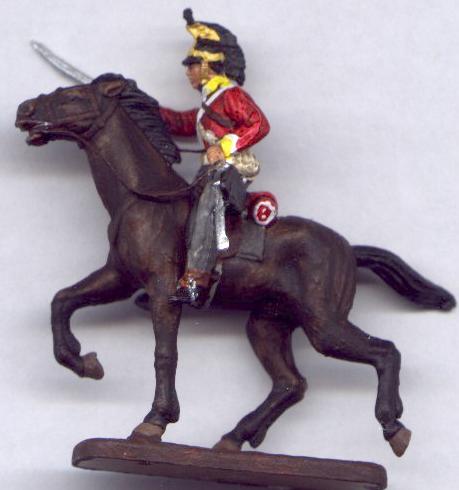
These fellows were the bad poster boys of their time and a constant source of irritation to Wellington. True to their nature, The Union Brigade charged at Waterloo and kept on charging, not returning until exhausted and spent. But this has been a problem of cavalry since ancient times.
"And finally, Royal Marines, officer and private, as they would have appeared at Trafalgar in 1805. OK, not much chance of anyone doing naval subjects, so I had to do my own. These guys were the most complicated of the bunch to produce, and I would like to thank the following who gave their lives that these two might live: The officer's legs and left arm are from the officer of Esci Napoleonic Russians - his right arm, body and head are from the ensign of Esci Napoleonic British Infantry, and the bicorn hat is from the officer in Revell's Imperial Guard. The private can thank an Esci Russian Infantryman for his legs, an Italeri Highlander for his body and arms, and the officer in Imex ACW Union Infantry for his hat (with suitable scratchbuilt extras)."
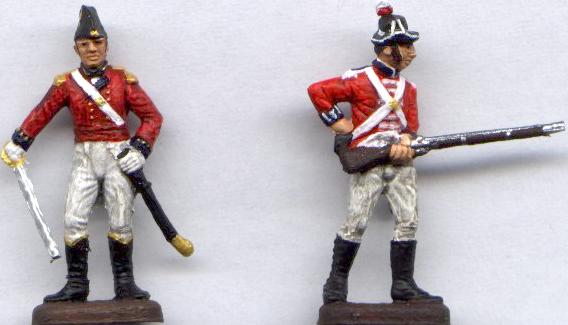
This last one was indeed a head scratcher as I had failed to identify any of the body parts until reading the accompanying text. The marines were Britain's 19th century's version of the modern strike force. Anywhere that ships could go (and that was anywhere), Britain could land a highly disciplined force and strike at Napoleon's continental system. And as fans of C.S. Forester's books can attest, that was a real thorn in Napoleon's side. Though no major victory was won, Britain's ships and marines tied down a significant source of Napoleon's manpower which could have been crushing Prussians or Austrians elsewhere.
"So there you have it. A gruesome display of transposed body parts, but a fun hobby that has filled many a long winter's evening. P.S. All scans are in 300 dpi."
Dave Keen
Editor's final note: Many thanks to Dave Keen for his excellent conversions. It often requires exquisite knowledge of today's vast range of plastics to come up with new and interesting conversions. These conversions have demonstated this in putting together such diverse components as the Guards band and Napoleonic bodies or WWI and Colonial War bodies. And Dave, if you need more evenings at home, you should consider moving to Seattle where it has rained the last 27 of 30 days, yes indeed, you could also be spending Autumn, Winter and Spring evenings at home doing your conversions here.